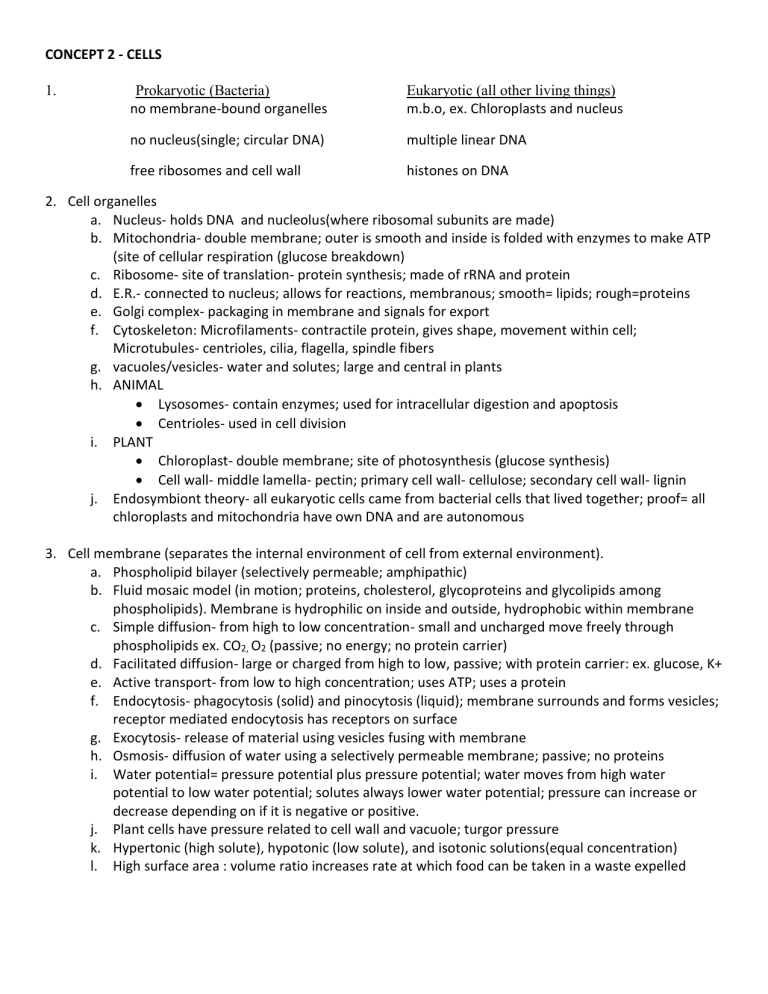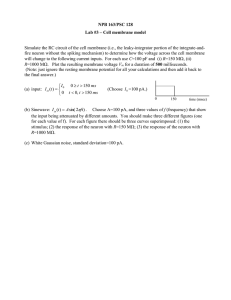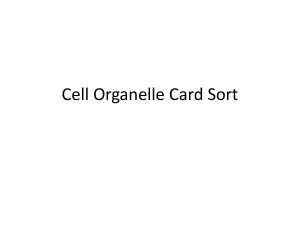Cell Biology Worksheet: Prokaryotes, Eukaryotes, Membranes, Nervous System
advertisement

CONCEPT 2 - CELLS 1. Prokaryotic (Bacteria) no membrane-bound organelles Eukaryotic (all other living things) m.b.o, ex. Chloroplasts and nucleus no nucleus(single; circular DNA) multiple linear DNA free ribosomes and cell wall histones on DNA 2. Cell organelles a. Nucleus- holds DNA and nucleolus(where ribosomal subunits are made) b. Mitochondria- double membrane; outer is smooth and inside is folded with enzymes to make ATP (site of cellular respiration (glucose breakdown) c. Ribosome- site of translation- protein synthesis; made of rRNA and protein d. E.R.- connected to nucleus; allows for reactions, membranous; smooth= lipids; rough=proteins e. Golgi complex- packaging in membrane and signals for export f. Cytoskeleton: Microfilaments- contractile protein, gives shape, movement within cell; Microtubules- centrioles, cilia, flagella, spindle fibers g. vacuoles/vesicles- water and solutes; large and central in plants h. ANIMAL Lysosomes- contain enzymes; used for intracellular digestion and apoptosis Centrioles- used in cell division i. PLANT Chloroplast- double membrane; site of photosynthesis (glucose synthesis) Cell wall- middle lamella- pectin; primary cell wall- cellulose; secondary cell wall- lignin j. Endosymbiont theory- all eukaryotic cells came from bacterial cells that lived together; proof= all chloroplasts and mitochondria have own DNA and are autonomous 3. Cell membrane (separates the internal environment of cell from external environment). a. Phospholipid bilayer (selectively permeable; amphipathic) b. Fluid mosaic model (in motion; proteins, cholesterol, glycoproteins and glycolipids among phospholipids). Membrane is hydrophilic on inside and outside, hydrophobic within membrane c. Simple diffusion- from high to low concentration- small and uncharged move freely through phospholipids ex. CO2, O2 (passive; no energy; no protein carrier) d. Facilitated diffusion- large or charged from high to low, passive; with protein carrier: ex. glucose, K+ e. Active transport- from low to high concentration; uses ATP; uses a protein f. Endocytosis- phagocytosis (solid) and pinocytosis (liquid); membrane surrounds and forms vesicles; receptor mediated endocytosis has receptors on surface g. Exocytosis- release of material using vesicles fusing with membrane h. Osmosis- diffusion of water using a selectively permeable membrane; passive; no proteins i. Water potential= pressure potential plus pressure potential; water moves from high water potential to low water potential; solutes always lower water potential; pressure can increase or decrease depending on if it is negative or positive. j. Plant cells have pressure related to cell wall and vacuole; turgor pressure k. Hypertonic (high solute), hypotonic (low solute), and isotonic solutions(equal concentration) l. High surface area : volume ratio increases rate at which food can be taken in a waste expelled 4. Nervous System a. function: sensory input, motor function, regulation b. structure: neuron, axon, dendrites, synapse c. Polarized neuron: Na+ outside, K+ and Cl- inside d. Depolarization moves Na into neuron, generating an action potential e. Repolarization exchanges Na+ and K+ through the sodium-potassium pump f. At synapse, calcium channels open to allow calcium to rush in, stimulating release of neurotransmitters g. Neurotransmitters released into synapse to generate action potential for motor neuron or muscle cell Vocabulary active transport amphipathic apoptosis aquaporin axon carrier protein cell wall centrioles channel protein chloroplast concentration gradient cytoplasm cytoskeleton dendrites depolarization diffusion endocytosis endoplasmic reticulum Golgi apparatus hypertonic hypotonic isotonic ligand lysosome membrane mitochondrion neuron neurotransmitter nuclear envelope phospholipid plasma membrane plasmolysis polarization prokaryotic cell repolarization ribosome rough ER selectively permeable smooth ER synapse exocytosis eukaryotic cell facilitated diffusion flagella fluid mosaic model nucleus organelles osmosis passive transport phagocytosis surface area: volume ratio transmembrane protein vacuole Thinking Practice 1. For each molecule shown to the right, answer the following, providing justifications for each: a. Is it polar or nonpolar? b. Is it hydrophobic or hydrophilic? c. In order to be transferred into a cell, would the molecule require a protein channel? 2. Biological systems rely heavily on the properties of water movement. Excretion, digestion, and blood pressure are just a few examples of situations where water balance is important. Suppose you have a semi-permeable membrane that ONLY water can pass. On one side of the membrane you have 0.1 M CaCl2. On the other side of the membrane, you have 0.1 M Glucose. CaCl2 ionizes in water to produce 3 ions. Glucose does not ionize in water. 0.1 M CaCl2 0.1 M Glucose a. Calculate the water potential for each side of the membrane. b. Describe which way water will move and explain your answer. 3. 4. The following diagram shows an action potential of a neuron. For each question, you can answer with one letter or multiple letters. a. At which letters would you find Na+ voltage gated channel OPEN? b. At which letter(s) would you find the Na+/K+ pump WORKING? c. At which letter(s) would you find K+ voltage gated channels OPEN? d. At point F, would there be a more positive charge on the INSIDE or OUTSIDE of the neuron? e. At point B, would you find more Na+ on the INSIDE or OUTSIDE of the neuron? f. Tetrodotoxin is a neurotoxin that blocks Na+ voltage gated channels. How would the function of the neuron be altered by the presence of this toxin? 5. Tay-Sachs disease is a human genetic abnormality that results in cells accumulating and becoming clogged with very large and complex lipids. Which cellular organelle must be involved in this condition? Cells – Long Free Response (10 points)




